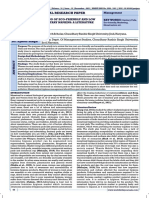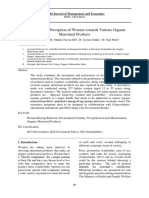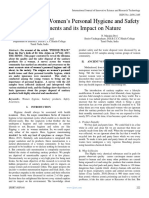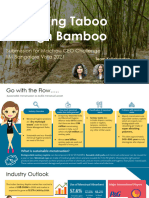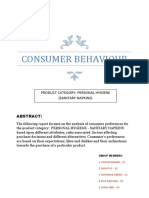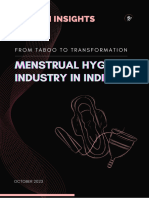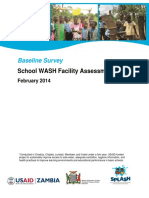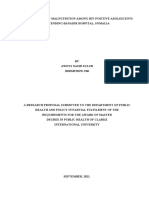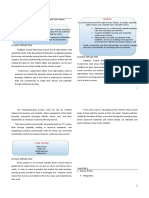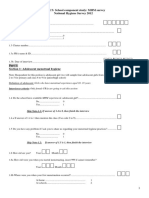Bio-Degradable and Reusable Sanitary Napkins: A Green Remedy For Period Care
Bio-Degradable and Reusable Sanitary Napkins: A Green Remedy For Period Care
Copyright:
Available Formats
Bio-Degradable and Reusable Sanitary Napkins: A Green Remedy For Period Care
Bio-Degradable and Reusable Sanitary Napkins: A Green Remedy For Period Care
Original Title
Copyright
Available Formats
Share this document
Did you find this document useful?
Is this content inappropriate?
Copyright:
Available Formats
Bio-Degradable and Reusable Sanitary Napkins: A Green Remedy For Period Care
Bio-Degradable and Reusable Sanitary Napkins: A Green Remedy For Period Care
Copyright:
Available Formats
Volume 8, Issue 8, August – 2023 International Journal of Innovative Science and Research Technology
ISSN No:-2456-2165
Bio-Degradable and Reusable Sanitary Napkins:
A Green Remedy for Period Care
Neha Barari1 Poonam Thakur 2
Assistant Professor Assistant Professor
Obstetric and Gynaecological Nursing Medical Surgical Nursing
Komal Sharma3
Assistant Professor
Obstetric and Gynaecological Nursing
Abstract:- Periods, also known as menstruations, are At the reproductive age, menstruation is a physical
regular vaginal bleeding that take place as part of a phenomenon that is natural for females. Nonetheless, it is
woman's monthly cycle. Women body gets ready for surrounded by superstitious beliefs and societal stigmas.
pregnancy each month. The uterus, also loses its lining if Lack of awareness and understanding about menstruation
there is no pregnancy. Maintaining good menstrual might result in unsafe hygiene habits, which in turn raises
hygiene and health will help us to avoid infections, lessen the risk of genitourinary and reproductive tract infections,
odours, and keep at ease when we are on our period. To cervical cancer, school abandonment, low academic
absorb or collect blood during period, we can choose performance, and an all-around low level of life quality.
from a variety of menstruation goods, such as sanitary (Zelalem Belayneh & Birhanie Mekuriaw)
pads, tampons, menstrual cups, menstrual discs and
period pants. Here aren't any official data, but according Females those are menstruating require safe feminine
to a number of reports, India produces roughly 9000 items that allow women to go about their regular lives
tonnes of waste from menstruation on a monthly without experiencing physical restrictions. Many years back
average, with the majority of it in the kind of feminine during the time of menstruation women were using natural
hygiene products. All of these sanitary pads made of items. But time by time these natural items were replaced by
plastic are either tossed in the trash or flushed down new materials. Several females who have periods choose to
toilets with other garbage from the home. In India, utilize sanitary pads all the way through their cycle in order
numerous women use sanitary pads. The vast majority to control the blood flow. Yet over the time, numerous
of the pads are made of plastic. Menstrual products, studies have brought attention to the dangers of
mostly sanitary napkins, are responsible for around 45% these sanitary napkins, warning that, these items are harmful
of the nation's overall sanitary waste generation, for the body as well to the environment also.
according to the Menstrual Health Alliance India. The
objectives of this paper is to assess the knowledge, Future generations' health will be impacted by the
practice, attitude and perception regarding choices they make today on reproductive health. As these
Biodegradable sanitary napkins among reproductive age pads contain plastic material, Synthetic plastic components
group females and to assess the comparison between have been incorporated to these pads as a liquid absorbent
biodegradable sanitary napkins and reusable sanitary for the best results. Another feature added to the various
napkins. sanitary pads sold in shops is aroma, which gives the user a
fresh feeling. There is now considerable fear that certain of
Keywords:- Menstruation, Sanitary Napkins, these substances, which are found in sanitary napkins, may
Biodegradable. have negative health effects on customers.
I. INTRODUCTION Sanitary pads have experienced a number of
improvements since their creation. The first material used
Adolescence is the time between childhood and for these pads were Flannel or woven cloth. After that cotton
adulthood and is marked by significant physical, and gauze-based sanitary pads were introduced. For the
psychological, and social changes . Menstruation, also good absorption capacity cellulose were also used. Further
known as having a menstrual period, begins with menarche modification include the belt pad that was introduced first,
and is a significant biological change that adolescent then the beltless pad with adhesives quickly took its place.
females must learn to maintain. (Yohannes Habtegiorgis
,Tadesse Sisay,Helmut Kloos,Asmamaw Malede,Melaku Over the past twenty years, the market for sanitary
Yalew,Mastewal Arefaynie,Yitayish Damtie,Bereket pads in India has grown quickly. The quantity of sanitary
Kefale) pads supplied in India doubles every five years, with close
to 1.25 billion pads sold in 2006. Sales of sanitary napkins
increased in the nation to 5.12 billion pieces in 2016, and by
2021, they were projected to reach 10.31 billion. However
IJISRT23AUG295 www.ijisrt.com 995
Volume 8, Issue 8, August – 2023 International Journal of Innovative Science and Research Technology
ISSN No:-2456-2165
there is currently no information on the precise quantity of the adhesive, which is used sparingly. Therefore, it is
pads that will be supplied in 2021. necessary to incorporate extended producer responsibility
into the system. The trash produced by sanitary product
Menstrual cups and reusable pads made of cotton, manufacturers has to be held accountable. The napkins
which have little to no environmental impact, are popular should be ISO 17088:2021-certified by government-
among women. Many people now select 'biodegradable' authorized testing facilities, which explains the steps and
sanitary napkins. However, there is still disagreement over requirements for identifying and marking items made of
how environmentally friendly these biodegradable napkins plastics acceptable for aerobic composting. ISO 17088:2021
are. specifies the methods and requirements for testing facilities.
Consumers must be aware of the products they are buying.
However, because reusable products have a longer
useful lifespan, we may be able to maximise the value of the Decomposition of a biodegradable pad typically takes
emissions by using them for a longer time. We use fewer ninety to one eighty days. Within the allotted time,
menstrual cups, reusable cloth pads, and period underwear, compostable napkins can breakdown in the soil without
which reduces our garbage production, carbon dioxide harming the environment. Normally, fully compostable
emissions, and spending. Because they last longer than sanitary pads are confused with biodegradable or oxo-
disposable sanitary napkins, reusable menstruation cups and degradable sanitary pads. The negative perception and lack
cotton napkins reduce the amount of waste that these goods of understanding of sanitary waste disposal are both a result
produce over time. of a lack of education at all levels. The science underlying
them and their disposal is frequently unknown to the
We also need to know that compost ability is not the administration.
same thing as biodegradability. All biodegradable materials
are compostable, but not all biodegradable materials are Information, communication, and education (IEC) and
compostable. Biodegradable materials dissolve naturally and capacity building to spread awareness of more ecologically
eventually vanish entirely, but occasionally they can leave friendly products and methods of disposal should be among
behind leftovers. Compost made from compostable waste, our long-term goals in India.
on the opposite hand, is nutrient-rich and good for plants.
Research Problem Statement
Materials that can be burned are biodegradable and The present review was aimed to gain a comprehensive
have the added advantage of doing so. In other words, as understanding of the knowledge, practice and attitude or
they rot, they release essential nutrients into the soil, perception regarding bio-degradable sanitary napkins. The
promoting plant development. The majority of these narrative review had been divided into four sections. Each
'biodegradable' pads make the promise to be compostable section examined several related studies. These sections are:
and chemical-free. Super-absorbent polymer (SAP) and
wood pulp are often removed from biodegradable pads, but First section deals with the knowledge regarding
some plastic is kept for waterproofing. Biodegradable sanitary napkins among reproductive age
group females.
There is one question that is if the biodegradable, Second section deals with the practice regarding
organic-tagged pads have plastic inserts and bleached white Biodegradable sanitary napkins among reproductive age
cotton outer layers, how are they any better than disposable group females.
napkins. So here is the answer that these 'biodegradable' Third section deals with the attitude and perception
sanitary napkins are not totally compostable, it would not be regarding bio-degradable sanitary napkins among
inaccurate to claim. The findings imply that while these reproductive age group females.
feminine hygiene products are not compostable, they may be Fourth section deals with the comparison between bio-
biodegradable over time due to a little quantity of plastic degradable sanitary napkins and reusable sanitary
covering. Whether they are actually sustainable and eco- napkins.
friendly choices is still up for debate. The ingredients that go
into making a serviette decide whether it is regular or green. Objectives
Because of its texture and look, non-woven
To assess the knowledge regarding Biodegradable
polypropylene or perforated polyethene used as the top layer
sanitary napkins among reproductive age group females.
is commonly mistaken for cotton. It cannot, however, be
To assess the practices regarding Biodegradable sanitary
composted. Additionally, around twenty five to thirty
percentage of the overall weight of a sanitary napkin is made napkins among reproductive age group females.
up by the polyethene back and top layers combined. To assess the attitude and perception regarding
Biodegradable sanitary napkins among reproductive age
The barrier plastic layer, which is often employed group females.
underneath the top permeable layer, the super-absorbent To assess the comparison between biodegradable
polymer, and the hot-melt adhesive in sanitary pads are all sanitary napkins and reusable sanitary napkins.
frequently made of non-compostable materials. The
remaining parts need to be changed, with the exception of
IJISRT23AUG295 www.ijisrt.com 996
Volume 8, Issue 8, August – 2023 International Journal of Innovative Science and Research Technology
ISSN No:-2456-2165
II. METHODS for roughly 1.5 hours to create an extremely thin sheet.
The muslin fabric was utilized to wrap the organic cotton
A narrative review was designed. A systematic after it was spread out on the thin banana sheet. The
electronic search was used to identify relevant studies. Only entire package of sheets are coated in the softened
original research paper were used in the study. The canvas fabric, and either a heat source is used to help the
electronic databases searched were: Research gate, PubMed, canvas cloth corner attach to the pad, or the edge of the
Scopus, Google scholar and Allied Health Literature pad can be sewn. Sanitary pads have a multi - layered
(CINHAL). composition, and every surface should serve a particular
purpose. Materials included banana fibre, organic cotton,
The existing literatures were very systematically opted muslin fabric, and canvas fabric. Banana fibre is a
to recruit into this narrative review. material that occurs naturally which is totally
biodegradable, safe for both people and the environment.
Inclusion Criteria Because to its non-aggravating, tissue-friendly, and basic
fluid control features, organic cotton has become one of
Original research papers related to the topic. the widely accepted building ingredients in pads for the
The document which is available in full text and is top layer. Recent years have seen an increase in the use
widely accessible online. of biological resources to address global issues. This
Studies that are presented in English. study shown that it is both economical and
Research studies published from the year 2017 environmentally friendly to manufacture sanitary
onwards. feminine items using biodegradable materials though
rather than non-biodegradable ones.
Exclusion Criteria Md. Moynul Hassan Shibly, Mohammad Anower
Hossain, M. Forhad Hossain (2021) has conducted a
Poor quality journal articles. study titled “ A development of biopolymer-based
A research articles without having ISSN number. menstrual pad and quality analysis against commercial
Research studies that are not listed in a journal data merchandise” with objective to substitute SAP with
base. ecologically friendly biopolymer and supply village poor
women competent performance and characteristics,
Research studies for which there is an abstract
design a sanitary and biodegradable pads. For such
accessible.
experimental study, the authors decided tissue paper,
Outcome viscose fibre, and hundred percentage cotton as the base
Knowledge regarding bio-degradable sanitary napkins material. Commercial-grade sodium alginate and CMC
were employed in substitution of SAP to manufacture
sanitary napkin sample and with no modification. Neem
Namrita Rai, Faine Crimbly, Summaya Aftab, Aleena
extracted was used on non-woven cloths utilizing reagent
Baig,Nathaline Fernandes, Syed Uzair Mahmood
grade citric acid at Merck, India, as a glue. Throughout
conducted a cross sectional study on An assessment of
this study, fresh green neem leaves from neem trees
knowledge and practices relating to the usage of sanitary
cultivated in Bangladesh were utilized to manufacture an
pads in march 2019. 391 ladies were chosen by a
extracted solution which was employed to first handle
convenience sample method. Structured formed
manufactured non-woven fabrics. As per the report's
questionnaires were used for collection of data. The
findings, neem extract is known to cure the non-woven
participants in this study were 391 girls from the city,
fabric that offers the pads its bactericidal functionality
with ages ranging from 15 to 45. 95.7% of these
even while promoting its softness and user-friendliness.
respondents’ favoured menstrual pads over to toilet
Increased performance can be observed in nonwoven
paper, cloth, tampons, and menstrual cups. According to
textiles processed with fifty percentage neem, as well as
common perception among females who use
all samples of sanitary napkin pads being manufactured
menstrual pads, failure to change pads frequently while
to use these textiles.
bleeding may raise the likelihood of developing
infections (p 0.01). The results revealed that several Christopher Chakwana1, Londiwe Nkiwane etall(2014)
females are conscious about the dangers of using carried out study with tittle”Development of a Low Cost
menstrual pads and are well informed on how to utilize Re-usable Microfibre Sanitary Pad” and objective of the
them. Also, the research found no evidence of a major study was to Construct a biodegradable microfiber
sanitary pad. To test for determination and resistance to
risk of negative effects related to the usage of menstrual
wicking, researcher performed wicking procedures. The
pads.
vertical strip experimentation will assess the pad's ability
Rahul Vinod Nair and Rachana RK Nair College of
to soak up fluids. The Ugandan Standard Tests for
Agriculture, Parul University, Vadodara conducted study
Sanitary Towels Document's EAS 96:2008-Annex C was
on sanitary pads from banana pseudo stem waste in feb
followed when conducting absorbency trials. Such
2021. Banana fibre is typically extracted from the tree's
techniques relied on weighing alterations in the pad that
pseudo-stem. Following extraction, the fibres then
used a balance to compute the quantity of fluid that had
divided into tiny pieces and boiling for one hour in one
absorbed. The vertical wicking test was performed as
fifty milliliters of distilled water and five grammes of
part of the study reported that the all three pads in all
sodium hydroxide. The liquid is then given time to cool
IJISRT23AUG295 www.ijisrt.com 997
Volume 8, Issue 8, August – 2023 International Journal of Innovative Science and Research Technology
ISSN No:-2456-2165
five depths demonstrated comparable wicking, with the have an impact on women's health. Agricultural and
Micro-fibre pad indicating a higher percentage of plant-based fibres are the greatest substitute for these
wicking than the available commercially sanitary pads. synthetic materials since they are widely available, non-
A polyethylene material had been examined to determine toxic, environmentally benign, and biodegradable. The
whether it could prevent blood from seeping through in goal of the project is to develop sanitary napkins with
order to prevent blood leaks. A polyethylene material's antimicrobial finishes by conducting preliminary tests on
capacity to inhibit blood from seeping has been plant fibres from Sansavieriatrifasciata. To improve the
examined in an attempt to avoid bleeding leakage. The fibres' ability to absorb moisture, Sansevieria trifasciata
polyethylene covering proved to be an effective fluid leaves were pre-treated with scouring and bleaching
proof layer, according to the findings concluded from the before being used to make fibres. To give fibres an
research the majority of the ingredients for the fibre pads antibacterial effect, Rose damascena extract was
can be purchased locally, enabling it simple for a village microencapsulated. The current study finds that
woman to knit them together. Sansevieria trifasciata fibres microencapsulated have
Jyoti Choudhary, Dr Mahua Bhattacharjee, has antibacterial capabilities against a variety of pathogens,
conducted a study on Consumption Pattern of Sanitary including Escherichia coli, Pseudomonas sp., and
Napkin and Environment Degradation. The research Candida. Thus Sansevieria trifasciata plant fibers could
paper high spots the issue of women hygiene products be an ideal substitute for absorbent core used in sanitary
that are becoming a serious environmental issue due to pads.
the non-biodegradable raw materials. In the
manufacturing of most sanitary pads raw materials like III. PRACTICE REGARDING
wood pulp, polyethylene etc. are used consisting high BIO-DEGRADABLE SANITARY NAPKINS
carbon footprints poisoning habitat. Some firms use
alternative absorbent fibres like bamboo, jute, banana Krishnashree achuthan, Sharanya Muthupalani, and
fibre having lower level of carbon footprints. The Aswathy Sreedevi in 2021 has conducted a study on ‘A
findings of the paper have been based on a secondary novel banana fiber pad for menstrual hygiene in India: a
comparative study of firms which produce eco-friendly feasibility and acceptability study. One fifty five
sanitary napkins with those that use non-biodegradable participants from the rural and two hundred sixteen from
raw materials. It has been found that the firms using eco- the urban regions engaged in the quantitative
friendly raw materials cause a positive externality, investigation of feasibility and acceptability of the
whereas the latter cause a negative external effect. Study banana fiber based menstrual pads. We took into account
concluded that sixty one percentage of women’s research subjects who had taken banana fiber based
population are aware of negative impact of synthetic menstrual pads for longer than four months in order to
sanitary napkins on environment. Only thirty two of increase the validity of the FA study. The data has been
women are aware of organic sanitary napkins and twenty collected from the respondents of various states like
eight of women find it easy to purchase them. Moreover, Bihar, Delhi, Karnataka, Kerala, Maharashtra, Tamil
sanitary napkins are dumped un-hygienically, ninety nine Nadu and West Bengal. Exploratory factor analysis and a
percentage of women throws sanitary pads in open by Cronback's reliability test were used to construct and
wrapping it and dumping in household garbage. The evaluate a twenty two-item as a survey tool. The findings
research paper concludes that according to the women showed that both respondents groups found BFPs to be
preference in feminine hygiene products the sanitary highly feasible and acceptable. The findings showed that
napkin market fails as women preference is synthetic there is high feasibility and acceptability rate of BFPs in
sanitary pads due to its low cost but such pads degrade both groups of respondents that is rural (eighty two
environment and are non-decomposable. percentage), urban (eighty percentage) feasibility rate
Dr. Mekala M1, Sri Ramakrishna has conducted a study and rural eighty percentage, urban seventy eight
titled “Development of Eco-Friendly Sanitary Napkins percentage acceptability rate. Key banana fiber based
using Sansevieria trifasciata Fibres coated with Rosa menstrual pads qualities including leakage and comfort
damascena Extracts”. The present paper highlights the were compared to the respondents' earlier practises, and
issue of non-biodegradability of commercial sanitary the results showed that respondents were overall satisfied
pads and importance of using Sansevieria trifasciata with the outcomes of BFPs and would suggest them to
plant fibres as biodegradable and eco-friendly absorbent others.
core in sanitary napkin. Commercial pads are non- Jasmin Foster, Paul Montgomery conducted a study with
biodegradable causing accumulation of menstrual waste title “A Study of Environmentally Friendly Menstrual
and degradation of environment. A study estimated that Absorbents in the Context of Social Change for
on an average three thirty five million menstruating Adolescent Girls in Low- and Middle-Income
women dispose four thirty two million pads every Countries”. In order to determine every material's unique
month. These sanitary pads are non-biodegradable and absorption rate, the investigators used four distinct types
remain in the landfills for about eight hundred years. of natural biodegradable material: (a) hundred
Wood pulp is the major raw material which is used as percentage cotton terry cloth, (b) hundred percentage
absorbent core in feminine hygienic product. But over hemp cloth, (c) hundred percentage bamboo wadding,
usage of these natural resources will lead to and (d) hundred percentage linen. To make the study's
deforestation. Chemicals in commercial sanitary napkins results highly authentic, a gelatine solution was applied
IJISRT23AUG295 www.ijisrt.com 998
Volume 8, Issue 8, August – 2023 International Journal of Innovative Science and Research Technology
ISSN No:-2456-2165
to mimic the thickness of menstrual blood. Then, ten g of Disposable Feminine Sanitary Napkins using Banana
gelatine being poured to three hundred ml of water that Fibres” Sanitary napkins are used by women for
was then warmed to sixty °C while still being stirred protection during their periods all around the world.
when it is no further observable gelatine particles Only a small portion of women in India use sanitary
remained. Afterwards, fifteen to twenty ml. quantities of napkins. The fundamental explanation for such a low
the liquid were divided up for every cloth. After that, a number has to do with peoples' ability to pay. The
reliable analytical tool was utilized to weight each of the current generation of sanitary napkins are non-
test cloths. According to the study's findings, bamboo biodegradable and dangerously infectious, which has an
wadding has a better adsorption index (7.86) than cotton impact on women's health. Sanitary bio napkins are
terry cloth (0.84), hemp cloth (1.4), linen (1.57), and created from natural materials to get over this problem.
commercial sanitary pads (0.84), amongst many other Banana fibre and cotton, which are readily available,
materials (4.38). Despite the bamboo wadding's has high bio-degradable, and inexpensive materials, were used in
absorbency index. The study's findings revealed that the the current investigation. Using natural materials had the
gelatine mixture was employed to analyze a variety of added benefit of being more porous and retaining fluid
biodegradable materials' absorbency rates and for a longer period of time. The findings showed that the
corelate them to commercial sanitary pads. Comparing napkins are environmentally friendly and have no
bamboo wadding to hemp fabric, linen, and cotton terry harmful impacts on women.
cloth, it was found that bamboo proved to be the most
absorbent natural material. IV. COMPARISON BETWEEN
Afi Agbaku Alimatu Sadia Yahaya, Feng Junhua, Shi BIO-DEGRADABLE AND REUSABLE
Chengqi, Wangkung Linda has conducted a research SANITARY NAPKINS
study titles “Jute Plant- A Bio-Degradable Material in
Making Sanitary Pad for Sustainable Development Mehta Sumita, Grover Anshul, Mittal Nalini, Nanda
Comfort”. The study intends to shed light on the usage of Pratibha, Khatuja Ritu, Naseem Azra has conducted a
the Jute Plant in place of the chlorine-bleached wood research study titles “Reusable sanitary napkins-time to
pulp or cotton and packaging, achieving Environmental revisit”. The main objectives of this study was to assess
Sustainability by improving access to economical, knowledge, attitude and practices (KAP) of women
biodegradable, and healthful sanitary napkins. The regarding menstrual hygiene and to evaluate the use of
research was developed based on the findings of a survey reusable sanitary napkins as an alternative to disposable
of women (both employees and students) and secondary sanitary napkins. The study has been done in 2 phases.
data gathered from studies, articles on female hygiene, Fifty married women who were presenting to the
Sustainable development targets, and the Research gynaecology OPD in the first part of the study were
Institute on Jute Plant. Many women are willing to instructed to use reusable sanitary napkins for two
switch their sanitary napkins for more affordable and months. To exclude genital infection, vaginal swabs
biodegradable ones, and the jute plant can be used to were tested before and after use. Reusable sanitary
replace the non-biodegradable materials used in creating napkins were found to be satisfactory and the trial was
them. Providing a platform so that women can obtain expanded in the second phase to include an additional
affordable sanitary products while also protecting the 534 women. For all women, a KAP analysis of menstrual
environment. By restoring the environment to its initial hygiene was conducted. After two months of use, phase
condition after use, one can support sustainable 1 of the study's microbiological analysis found no
development. A quick survey was conducted to learn pathogenic organisms on vaginal swab culture. Only
more about how often women use sanitary products, 26% of the 584 women analysed by KAP were aware of
other aspects of female hygiene, and the environmental menstruation before menarche, and their mothers were
impact of sanitary napkin disposal. This study, which the main information source for 51.88% of them. In the
focused on gathering information on the types of sanitary survey, 76.54% of the women used disposable sanitary
napkins women used and whether they would choose napkins, with 15% of them being disposed of in an
one that was healthy, environmentally friendly, and unclean manner. Of the 80.49% women who used the
economically advantageous over a more traditional reusable napkins, 83.6% said they would recommend
option, used an online survey form provided by them to others. An efficient, cost-efficient, and
esurveycreator.com to collect the necessary data. This environmentally responsible replacement for throwaway
was mostly done to get a broad overview of some of the napkins are reusable sanitary pads.
problems women run into during their periods and some Sassone Samantha Ciardi, Silva Susan, Metzger
of the methods they employ to deal with those problems. Jed, Fisher Nevan, Ambily Mohan, Irene Felsman has
Of the hundred participants the link was shared with, conducted a research study on titled Reusable sanitary
sixty participated and provided a total of nine hundred napkins in rural India: a remote quality improvement
eighty eight answers to the twelve questions that were project for adolescent girls promoting menstrual hygiene
posed. health during the COVID-19 pandemic. In this
Priya Petchimuthu, Ramya Petchimuthu, Sarah Afreen experiment, 50 teenage girls from rural Tamil Nadu,
Basha, Ramya Krishnaveni Murugan, Harshi Sundara India, had pre- and post-intervention assessments of their
Ganapathy, Uma Maheshwari Durairaj has conducted a menstrual knowledge, usage of reusable feminine
study on “Production of Cost Effective, Biodegradable, hygiene items, the number of days at school skipped
IJISRT23AUG295 www.ijisrt.com 999
Volume 8, Issue 8, August – 2023 International Journal of Innovative Science and Research Technology
ISSN No:-2456-2165
because of periods, thereby menstrual practises, and this had some positive effects on self-reported
needs. The intervention involved the provision of MHM involvement in daily activities.
kits to all participants as well as an MHM teaching Ramsay Caitlin, Hennegan Julie, Caitlin H Douglass,
programme on feminine hygiene care. Over the course of Eddy Sarah, Head Alexandra, Lim S C Megan has
120 days, the intervention was carried out in two phases. conducted a study titled “Reusable period products: use
Phase 1 was a 30-day period (4 December 2020–3 and perceptions among young people in Victoria,
January 2021) during which 50 adolescent girls were Australia”. Young people (aged 15–29) in Victoria,
recruited, pre-intervention evaluations were finished, and Australia, were the subjects of a yearly cross-sectional
the MHM intervention was implemented. These same survey that collected both quantitative and open-text
teenagers participated in Phase 2 during a 90-day period, qualitative data. Through carefully chosen social media
using the items in the MHM kit and completing the post- adverts, the convenience sample was gathered. We
intervention assessment at the conclusion of the phase. surveyed young people (n = 596) who reported
Participants were teenage girls (aged 10 to 19) who had menstruation within the previous six months to learn
experienced menarche and resided in Trichy or about their use of reusable materials, menstrual product
Tiruvannamalai, rural towns in Tamil Nadu, India. A usage, and product priorities and preferences. According
demographic survey was administered to participants to the study's findings, 37% of participants used reusable
before and after the intervention. It asked about current products during their most recent menstrual cycle (24%
age, age at which menstruation began, attendance at used period knickers, 17% used menstrual cups and 5%
school, religious affiliation, access to flowing water at used reusable pads), while a further 11% had attempted
home and at school, and existing methods for controlling to use reusable products in the past. Use of reusable
monthly periods. Adolescent characteristics, intervention products was linked to older age, Australian birthplace,
results, and intervention fidelity results were described and higher discretionary income. The need for early and
using descriptive statistics. The findings of this study better information, difficulties managing upfront costs
show a significant correlation between MHM awareness and availability of re-usable, good experiences with
and the utilisation of reusable feminine hygiene reusables, and difficulties using reusables, such as
products, leading to an improvement in menstrual washing reusables and changing them outside the home,
management skills and a reduction in absenteeism from were all mentioned by respondents. According to the
school. study's findings, many young people use recyclable
Hennegan Julie, Dolan Catherine, Wu Maryalice, Scott goods, with environmental concerns serving as a key
Linda, Montogomery Paul has done a Cross-sectional motivator.
study titled “Schoolgirls' experience and appraisal of
menstrual absorbents in rural Uganda: a cross-sectional V. CONCLUSION
evaluation of reusable sanitary pads”. The study's goals
were to assess the girls' perceptions of the dependability After studying in-depth about each and every research
and acceptability of various menstrual absorbents as well articles regarding knowledge, practice and attitude or
as their experiences using them. Second, to analyse perception regarding bio-degradable sanitary napkins
variations in expressed liberty in activities during periods among reproductive age group females we found that we
according to menstruation absorbent and compare can’t say there is no knowledge about bio-degradable
evaluations of freely offered pads that are reusable to sanitary napkins as in some of the studies we found average
other current methods of menstruation management. 205 or good knowledge about it. They are also aware about
menstruation schoolgirls from eight rural Ugandan organic sanitary napkins. But in most of the studies we
schools participated. The use of reusable pads provided found that less education hinders the level of knowledge and
by the intervention by 72 girls were compared to the use people are throwing this sanitary napkin in open area and
of pre-existing improvised methods (mostly new or used dumping in household garbage. Females are also having
fabric). The ratings of perceived absorbent reliability knowledge about negative impact of synthetic sanitary
across activities, ease of changing absorbents, and napkins on health and on environment. It won’t be wrong to
disgust with cleaning absorbents were all significantly say that menstrual hygiene products are necessity for women
higher among schoolgirls who used reusable pads. There and they must be aware of such products available in the
were no appreciable changes in the reporting of scent or market for their own health but we can’t deny the fact that
outer garment soiling during the most recent cycle of these products are harmful for the environment. After
menses. There were no differences between girls who studying the Act initiated by Indian Government it is
used reusable pads and those who used other methods concluded that there is lack of attention paid in this matter as
when asked if menstruation made them skip daily menstrual waste is treated as household waste under
activities. However, when asked which tasks they Municipal Solid Waste according to Consumption Pattern of
avoided when they were menstruating, women who used Sanitary Napkin and Environment Degradation.
reusable pads reported doing less exercise, working in
the garden, getting water, and cooking. The study's Due to various awareness programs and steps taken by
finding was that reusable pads were viewed favourably. Government there is widespread use of sanitary napkins in
Although there were no differences in the reports of urban area as well as the small set up of firms of sanitary
actual soiling and missed activities because of periods, napkin in rural area has increased its demand which has
increased the burden of menstrual waste growing every day.
IJISRT23AUG295 www.ijisrt.com 1000
Volume 8, Issue 8, August – 2023 International Journal of Innovative Science and Research Technology
ISSN No:-2456-2165
It’s high time that the awareness programme must be [6]. Pachauri, A. et al. (2019) “Safe and sustainable waste
directed in the right path where people gets pure knowledge management of self-care products,” BMJ (Clinical
of merits and demerits of highly preferred synthetic sanitary research ed.), 365, p. l1298. doi: 10.1136/bmj.l1298.
pads. There should be a balance between home and [7]. Pjponline.com. Available at:
environment as both health of women and environment are https://www.pjponline.com/what-is-the-difference-
equally important. Moreover, on the part of government, between-compostable-and-biodegradable/ (Accessed:
there must be support given to the new techniques producing July 17, 2023).
organic sanitary pads which are biodegradable like Saathi, [8]. Tewari, S. (no date) Sanitary napkins: Why
heyday etc. and some restriction must be out on use of biodegradable is not the same as
synthetic sanitary pads. Secondly, Government must compostable, Org.in. Available at:
segregate menstrual waste from household waste and https://www.downtoearth.org.in/blog/environment/sa
decompose them with different techniques and method nitary-napkins-why-biodegradable-is-not-the-same-
instead of burring them in landfills. Either they must be as-compostable-80657 (Accessed: July 17, 2023).
included under bio-chemical waste or separate category [9]. Chakravorty, J. (2020) Being biodegradable is not
must be formed under Consumption Pattern of Sanitary enough, sanitary pads need to be compostable, Times
Napkin and Environment Degradation. Of India. Available at: https://timesofindia.
indiatimes.com/life-style/health-fitness/health-
Scope for Further Research news/being-biodegradable-is-not-enough-sanitary-
pads-need-to-be-compostable/articleshow/78221448.
Appropriate period care knowledge should be included cms (Accessed: July 17, 2023).
in adolescence schooling and activists ought to promote [10]. Rai, N. et al. (2019) “An assessment of knowledge
knowledge of how toilet amenities may influence the and practices relating to the usage of sanitary
selection of products. pads,” International journal of community medicine
Researchers can develop a sustainable way of enhancing and public health, 6(4), p. 1411. doi: 10.18203/2394-
the world for the next generation by using natural 6040.ijcmph20191368.
materials in pads that are affordable to those with lesser [11]. Achuthan, K. et al. (2021) “A novel banana fiber pad
incomes. for menstrual hygiene in India: a feasibility and
Structured teaching programme for females to motivate acceptability study,” BMC women’s health, 21(1), p.
them for the use bio-degradable sanitary napkins. 129. doi: 10.1186/s12905-021-01265-w.
[12]. Shibly, M. M. H. et al. (2021) “Development of
REFERENCES biopolymer-based menstrual pad and quality analysis
against commercial merchandise,” Bulletin of the
[1]. Habtegiorgis, Y. et al. (2021) “Menstrual hygiene National Research Centre, 45(1). doi:
practices among high school girls in urban areas in 10.1186/s42269-021-00504-2.
Northeastern Ethiopia: A neglected issue in water, [13]. Chakwana, C. and Nkiwane, L. (2014) “Development
sanitation, and hygiene research,” PloS one, 16(6), p. of a low cost re-usable microfibre sanitary
e0248825. doi: 10.1371/journal.pone.0248825. pad,” Textiles and light industrial science and
[2]. Belayneh, Z. and Mekuriaw, B. (2019) “Knowledge technology, 3(0), p. 48. doi:
and menstrual hygiene practice among adolescent 10.14355/tlist.2014.03.008
school girls in southern Ethiopia: a cross-sectional [14]. A study on consumption pattern of sanitary napkin
study,” BMC public health, 19(1), p. 1595. doi: and environment degradation - AISECT
10.1186/s12889-019-7973-9. university (no date) Ipublisher.in. Available at:
[3]. PTI (2022) High amounts of harmful chemicals http://aujournals.ipublisher.in/p/58409 (Accessed:
found in sanitary napkins : Study, mint. Available at: July 17, 2023).
https://www.livemint.com/news/sanitary-pads-in- [15]. Mekala (2021) “Development of Eco-Friendly
india-contain-cancer-infertility-causing-chemicals- Sanitary Napkins using Sansevieria trifasciata Fibres
study-11669126591992.html (Accessed: July 17, coated with Rosa damascena Extracts,” International
2023). Research Journal on Advanced Science Hub
[4]. Kotler, J. (2018) A short history of modern menstrual (IRJASH), 3(SpecialICOST 2S), pp. 76–82. doi:
products, Clue. Available at: 10.47392/irjash.2021.043.
https://helloclue.com/articles/culture/a-short-history- [16]. Achuthan, K. et al. (2021) “A novel banana fiber pad
of-modern-menstrual-products (Accessed: July 17, for menstrual hygiene in India: a feasibility and
2023). acceptability study,” BMC women’s health, 21(1), p.
[5]. Chugh, K. (2022) “Menstrual Hygiene: A 129. doi: 10.1186/s12905-021-01265-w.
Fundamental Human right - Missing in [17]. Foster, J. and Montgomery, P. (2021) “A study of
India,” Himalayan Hemp, 27 November. Available environmentally friendly menstrual absorbents in the
at: https://www.himalayanhemp.in/post/menstrual- context of social change for adolescent girls in low-
hygiene-a-fundamental-human-right (Accessed: July and middle-income countries,” International journal
17, 2023). of environmental research and public health, 18(18),
p. 9766. doi: 10.3390/ijerph18189766
IJISRT23AUG295 www.ijisrt.com 1001
Volume 8, Issue 8, August – 2023 International Journal of Innovative Science and Research Technology
ISSN No:-2456-2165
[18]. Agbaku, C. A. et al. (2020) “Jute Plant- A bio-
degradable material in making sanitary pad for
sustainable development,” International journal of
scientific research and management, 8(06), pp. 162–
170. doi: 10.18535/ijsrm/v8i06.fe01.
[19]. “Production of cost effective, biodegradable,
disposable feminine sanitary napkins using banana
fibres” (2019) International journal of engineering
and advanced technology, 9(1S4), pp. 789–791. doi:
10.35940/ijeat.a1145.1291s419.
[20]. Mehta, S. et al. (2022) “Reusable sanitary napkins-
time to revisit,” Journal of public health (Oxford,
England), 44(2), pp. 356–362. doi:
10.1093/pubmed/fdaa192.
[21]. Ciardi Sassone, S. et al. (2022) “Reusable sanitary
napkins in rural India: a remote quality improvement
project for adolescent girls promoting menstrual
hygiene health during the COVID-19
pandemic,” Global health promotion, 29(3), pp. 77–
85. doi: 10.1177/17579759221082065.
[22]. Hennegan, J. et al. (2016) “Schoolgirls’ experience
and appraisal of menstrual absorbents in rural
Uganda: a cross-sectional evaluation of reusable
sanitary pads,” Reproductive health, 13(1), p. 143.
doi: 10.1186/s12978-016-0260-7.
[23]. Ramsay, C. et al. (2023) “Reusable period products:
use and perceptions among young people in Victoria,
Australia,” BMC women’s health, 23(1), p. 102. doi:
10.1186/s12905-023-02197-3.
IJISRT23AUG295 www.ijisrt.com 1002
You might also like
- BEESWAX WRAPS FINAL RESEARCH PAPER Smm.a.Document7 pagesBEESWAX WRAPS FINAL RESEARCH PAPER Smm.a.Tennnn0% (1)
- Banana PadsDocument14 pagesBanana PadsSunny RajopadhyayaNo ratings yet
- Congress 2023: National Children Science NCSC2023 Focal Theme - Understanding Ecosystem For Health and Well BeingDocument11 pagesCongress 2023: National Children Science NCSC2023 Focal Theme - Understanding Ecosystem For Health and Well Beinganuragojhaofficial2005No ratings yet
- Empowering Women's Health and Sustainability Through Eco Hygiene ProductsDocument11 pagesEmpowering Women's Health and Sustainability Through Eco Hygiene ProductsAJHSSR JournalNo ratings yet
- Marketing of Ecofriendly and Low Cost Sanitary Napkins A Literature Review December 2021 0046515237 7608843Document4 pagesMarketing of Ecofriendly and Low Cost Sanitary Napkins A Literature Review December 2021 0046515237 7608843Samridhi SinghalNo ratings yet
- Ijerph 18 05534 v2Document20 pagesIjerph 18 05534 v2KaranNo ratings yet
- Medical Aspects - Melbourne ConventionDocument25 pagesMedical Aspects - Melbourne Conventionsarara.incNo ratings yet
- ANOVELBAMBOOSANITARYPAD Revised2Document7 pagesANOVELBAMBOOSANITARYPAD Revised2Metty Ariani AniNo ratings yet
- Sanitary Napkins Their Contains Alternative and Safety - Lifeis4joy 1Document6 pagesSanitary Napkins Their Contains Alternative and Safety - Lifeis4joy 1prafulla patilNo ratings yet
- Development of Cost-Effective Menstrual Absorbent Pad With Eco-Friendly Antimicrobial FinishDocument20 pagesDevelopment of Cost-Effective Menstrual Absorbent Pad With Eco-Friendly Antimicrobial FinishMetty Ariani AniNo ratings yet
- UGC 5-PUBLISHED PAPER On Menstrual ProductsDocument14 pagesUGC 5-PUBLISHED PAPER On Menstrual Productsmatthewsmichelle111No ratings yet
- Manufacturing of Cost Efficient Sanitary Napkins Incinerator MachineDocument10 pagesManufacturing of Cost Efficient Sanitary Napkins Incinerator MachineTJPRC PublicationsNo ratings yet
- Mahesh 111 (2) .Odt - 0Document7 pagesMahesh 111 (2) .Odt - 0bobbiliravi18No ratings yet
- Addressing Plastic Pollution Through Green Consumption - Predicting Intentions To Use Menstrual Cups in The PhilippinesDocument9 pagesAddressing Plastic Pollution Through Green Consumption - Predicting Intentions To Use Menstrual Cups in The Philippinesbapdo2004No ratings yet
- A Survey About Women's Personal Hygiene and Safety Measurements and Its Impact On NatureDocument6 pagesA Survey About Women's Personal Hygiene and Safety Measurements and Its Impact On NatureInternational Journal of Innovative Science and Research Technology100% (1)
- Team Kollaborators - IIMK - MachauCEODocument13 pagesTeam Kollaborators - IIMK - MachauCEOusereddit6942No ratings yet
- Always PadsDocument12 pagesAlways PadsAiaman ShahzadNo ratings yet
- Humanities-Development of Herbal Finished Baby Diapers With Bamboo Fiber-G.malarvizhiDocument6 pagesHumanities-Development of Herbal Finished Baby Diapers With Bamboo Fiber-G.malarvizhiBESTJournals100% (1)
- Lowcost Sanitary Napkingenius..Document33 pagesLowcost Sanitary Napkingenius..Gangaprasad KarNo ratings yet
- Basic ConceptsDocument7 pagesBasic ConceptsNawazish AnsariNo ratings yet
- Disposable/ Bioplastic Utensils: Group 5 Bilo Cuyugan Espiritu Pabuna Pascual Sinlao Sta. Ana YumulDocument8 pagesDisposable/ Bioplastic Utensils: Group 5 Bilo Cuyugan Espiritu Pabuna Pascual Sinlao Sta. Ana YumulAngela Louise SmithsNo ratings yet
- Knowledge About Menstrual Cup and Its Usage AmongDocument5 pagesKnowledge About Menstrual Cup and Its Usage AmongAngel MontellanoNo ratings yet
- Doc-20240131-Wa0 240131 223939Document6 pagesDoc-20240131-Wa0 240131 22393922alhumidi2020No ratings yet
- 619pm - 10.EPRA JOURNALS 11211Document7 pages619pm - 10.EPRA JOURNALS 11211Sherin San felipeNo ratings yet
- Udaan Project, Memoon ZehraDocument8 pagesUdaan Project, Memoon ZehrazehramemoonNo ratings yet
- A Progress of Herbal Finish (Aloe Vera & Neem) in Infant Tank Tops in Mother's View PointDocument6 pagesA Progress of Herbal Finish (Aloe Vera & Neem) in Infant Tank Tops in Mother's View PointEditor IJTSRDNo ratings yet
- D 2Document24 pagesD 2Anay MehrotraNo ratings yet
- Sustainable Systems and Craft StudiesDocument16 pagesSustainable Systems and Craft StudiesYamina Zehra100% (2)
- Hierarchy of Solid Waste ManagementDocument6 pagesHierarchy of Solid Waste ManagementJustine joy EstoqueNo ratings yet
- Biotechnology YouDocument16 pagesBiotechnology YouDouglas FernandesNo ratings yet
- Womena Faq Do Menstrual Products Contain Harmful SubstancesDocument10 pagesWomena Faq Do Menstrual Products Contain Harmful Substancessimona.nuelyfe100% (1)
- Design of Napkin Incinerator: A Project ReportDocument9 pagesDesign of Napkin Incinerator: A Project ReportSreejith VasudevanNo ratings yet
- Writing A Capsule Research Proposal: Performance Task 1Document4 pagesWriting A Capsule Research Proposal: Performance Task 1Justin AdlawanNo ratings yet
- Sustainability ProjectDocument5 pagesSustainability Projectritwij kelshikarNo ratings yet
- Detergent Trends of TomorrowDocument3 pagesDetergent Trends of TomorrowGvsZahidNoorNo ratings yet
- Senior Research Final ThesisDocument25 pagesSenior Research Final Thesisapi-233210405No ratings yet
- A Descriptive Analysis of The Potential of Banana Fiber in Sustainable Menstrual Pad Production: A Comparative Study With Traditional Menstrual PADDocument4 pagesA Descriptive Analysis of The Potential of Banana Fiber in Sustainable Menstrual Pad Production: A Comparative Study With Traditional Menstrual PADfritzi resolaNo ratings yet
- A Mini Project OnDocument31 pagesA Mini Project Onvikas guptaNo ratings yet
- 6882-Article Text-12309-1-10-20210603Document15 pages6882-Article Text-12309-1-10-20210603abhihrvk1No ratings yet
- 42 Ecological and Economic Impact of The Use ofDocument3 pages42 Ecological and Economic Impact of The Use ofNyoman MahardikaNo ratings yet
- User Research ApplicationDocument29 pagesUser Research Applicationmaahigautam10No ratings yet
- Consumption of Sanitary Napkins&effect On Environmentals UstainabilityDocument8 pagesConsumption of Sanitary Napkins&effect On Environmentals UstainabilityInternational Journal of Application or Innovation in Engineering & ManagementNo ratings yet
- Coconut Coir As A Sustainable Alternative For Commercial FacemasksDocument9 pagesCoconut Coir As A Sustainable Alternative For Commercial FacemasksHannah EclarinoNo ratings yet
- Sample Proposal FormatDocument27 pagesSample Proposal FormatShaina Mae A. VillasotoNo ratings yet
- Disposing of A Sanitary FadDocument5 pagesDisposing of A Sanitary FadMomil FatimaNo ratings yet
- Weaving Research Paper - BiofibersDocument6 pagesWeaving Research Paper - Biofibersc2t9xhc6y9No ratings yet
- FSA III Final (Abhinav Achintya Basundhara Kevin Sarthak)Document10 pagesFSA III Final (Abhinav Achintya Basundhara Kevin Sarthak)achintya mishraNo ratings yet
- Consumer BehaviourDocument15 pagesConsumer BehaviourYashiNo ratings yet
- Activity 9 Let's Check and Let's AnalyzeDocument3 pagesActivity 9 Let's Check and Let's AnalyzeJean Tronco100% (5)
- Sana Group DocumentDocument4 pagesSana Group DocumentNEENARIKA JAMWALNo ratings yet
- Polymers For Advanced Techs - 2018 - Bashari - Cellulose Based Hydrogels For Personal Care ProductsDocument15 pagesPolymers For Advanced Techs - 2018 - Bashari - Cellulose Based Hydrogels For Personal Care ProductsrobaNo ratings yet
- Biology Project Final Class 12 InversDocument15 pagesBiology Project Final Class 12 InverstaanusarvNo ratings yet
- Final Report 1Document30 pagesFinal Report 1Gajendran A MECH KIOTNo ratings yet
- Unit 4 Blog PostDocument5 pagesUnit 4 Blog PostCarmen PrantilNo ratings yet
- Study of Adaptability and Efficacy of Menstrual CuDocument10 pagesStudy of Adaptability and Efficacy of Menstrual CuAnnisaaNo ratings yet
- Deadly Fungal Infections Are Growing Antibiotic Resistance Fungicides Used in Agriculture May Be Impacting The Effectiveness of Some MedicinesDocument18 pagesDeadly Fungal Infections Are Growing Antibiotic Resistance Fungicides Used in Agriculture May Be Impacting The Effectiveness of Some MedicinesFrank AquinoNo ratings yet
- Chap1 3Document33 pagesChap1 3Lorie Camille CasaclangNo ratings yet
- Ecological Footprint of DiapersDocument18 pagesEcological Footprint of Diaperstheycallmemoo100% (1)
- Remnant Fabrics: Recycling Into Garbage BagDocument4 pagesRemnant Fabrics: Recycling Into Garbage BagMayeth Silva Gonzales100% (1)
- Sustainable Fibers For Fashion IndustryDocument171 pagesSustainable Fibers For Fashion IndustryVanessa CampitelliNo ratings yet
- Phenotypic Diversity Assessment and Related Indigenous Knowledge of Yam (Dioscorea spp) in Ebonyi State, NigeriaDocument112 pagesPhenotypic Diversity Assessment and Related Indigenous Knowledge of Yam (Dioscorea spp) in Ebonyi State, NigeriaInternational Journal of Innovative Science and Research TechnologyNo ratings yet
- Sustainability in Alcohol Production: An Overview of Green Initiatives and their Impact on the IndustryDocument5 pagesSustainability in Alcohol Production: An Overview of Green Initiatives and their Impact on the IndustryInternational Journal of Innovative Science and Research TechnologyNo ratings yet
- Climate Adaptation and Capturing Innovative and Best Practices of Sudan Funded Projects for Knowledge ManagementDocument6 pagesClimate Adaptation and Capturing Innovative and Best Practices of Sudan Funded Projects for Knowledge ManagementInternational Journal of Innovative Science and Research TechnologyNo ratings yet
- Enhancing Biogas Yield by Co-Digestion of Cattle Dung and Acha (Digitaria Exilis) HullsDocument8 pagesEnhancing Biogas Yield by Co-Digestion of Cattle Dung and Acha (Digitaria Exilis) HullsInternational Journal of Innovative Science and Research TechnologyNo ratings yet
- The Impact of Price, Facilities and Experience in Maintaining the Sustainable Loyalty of Air Asia Passengers Using Satisfaction as a Mediating VariableDocument11 pagesThe Impact of Price, Facilities and Experience in Maintaining the Sustainable Loyalty of Air Asia Passengers Using Satisfaction as a Mediating VariableInternational Journal of Innovative Science and Research Technology100% (1)
- Next-Gen Talent Matching System: Innovating Recruitment with AI-Driven JD and CV MatchingDocument5 pagesNext-Gen Talent Matching System: Innovating Recruitment with AI-Driven JD and CV MatchingInternational Journal of Innovative Science and Research TechnologyNo ratings yet
- Perception of Victim Blaming: Basis for Community EducationDocument6 pagesPerception of Victim Blaming: Basis for Community EducationInternational Journal of Innovative Science and Research TechnologyNo ratings yet
- Determinants of the Exploitation of Groundwater Resources of the Alluvial Plain of KarfiguelaDocument4 pagesDeterminants of the Exploitation of Groundwater Resources of the Alluvial Plain of KarfiguelaInternational Journal of Innovative Science and Research TechnologyNo ratings yet
- Functionality of Google Maps and Parameter-based Efficient Eateries route DetectionDocument8 pagesFunctionality of Google Maps and Parameter-based Efficient Eateries route DetectionInternational Journal of Innovative Science and Research TechnologyNo ratings yet
- AI-Driven Algorithms: Transforming Customer Engagement with AI and Ethical Data PrivacyDocument9 pagesAI-Driven Algorithms: Transforming Customer Engagement with AI and Ethical Data PrivacyInternational Journal of Innovative Science and Research TechnologyNo ratings yet
- Adapting 'Rishi-Krishi' Perspectives in Safe Farming in Aadhikhola, Gandaki Province, NepalDocument10 pagesAdapting 'Rishi-Krishi' Perspectives in Safe Farming in Aadhikhola, Gandaki Province, NepalInternational Journal of Innovative Science and Research Technology100% (1)
- Spam Detection Using Large Datasets with Multilingual SupportDocument7 pagesSpam Detection Using Large Datasets with Multilingual SupportInternational Journal of Innovative Science and Research TechnologyNo ratings yet
- Nurses’ Knowledge Regarding Management of Burn Injury Patients at Selected Hospital in Dhaka, BangladeshDocument16 pagesNurses’ Knowledge Regarding Management of Burn Injury Patients at Selected Hospital in Dhaka, BangladeshInternational Journal of Innovative Science and Research TechnologyNo ratings yet
- A Field Survey to Investigate the Flora of Dharmashala Dhauladhar Range in North-Western Himalayan Region of IndiaDocument13 pagesA Field Survey to Investigate the Flora of Dharmashala Dhauladhar Range in North-Western Himalayan Region of IndiaInternational Journal of Innovative Science and Research TechnologyNo ratings yet
- Exploring the Role of Human Behavior Analytics in Strengthening Privacy-Preserving Systems for Sensitive Data ProtectionDocument16 pagesExploring the Role of Human Behavior Analytics in Strengthening Privacy-Preserving Systems for Sensitive Data ProtectionInternational Journal of Innovative Science and Research TechnologyNo ratings yet
- Optimizing Maternal Nutrition and its Impact on Fetal Development: Evidence-Based Insights and Current GuidelinesDocument4 pagesOptimizing Maternal Nutrition and its Impact on Fetal Development: Evidence-Based Insights and Current GuidelinesInternational Journal of Innovative Science and Research TechnologyNo ratings yet
- Examining How Police as a Security Function Fosters Socio-Economic Development in KenyaDocument16 pagesExamining How Police as a Security Function Fosters Socio-Economic Development in KenyaInternational Journal of Innovative Science and Research TechnologyNo ratings yet
- Chronic Low-Grade Systemic Inflammatory State and Insulin Resistance: Implications for Metabolic HealthDocument14 pagesChronic Low-Grade Systemic Inflammatory State and Insulin Resistance: Implications for Metabolic HealthInternational Journal of Innovative Science and Research TechnologyNo ratings yet
- Fatigue Failure Analysis of Notched Specimen with En19, En354 and En36c MaterialsDocument7 pagesFatigue Failure Analysis of Notched Specimen with En19, En354 and En36c MaterialsInternational Journal of Innovative Science and Research TechnologyNo ratings yet
- Aetiology of Hearing Loss in Cochlear Implantees: A Study of 191 Cases at CI Centre, CMH, DhakaISRT24DEC453Document6 pagesAetiology of Hearing Loss in Cochlear Implantees: A Study of 191 Cases at CI Centre, CMH, DhakaISRT24DEC453International Journal of Innovative Science and Research TechnologyNo ratings yet
- Application of Gestalt Theory in Interior Design Dinas Perpustakaan Dan Kearsipan Daerah Provinsi Jawa Barat (DISPUSIPDA)Document10 pagesApplication of Gestalt Theory in Interior Design Dinas Perpustakaan Dan Kearsipan Daerah Provinsi Jawa Barat (DISPUSIPDA)International Journal of Innovative Science and Research TechnologyNo ratings yet
- Optimising Web Application Development Using Ruby on Rails, Python, and Cloud-Based ArchitecturesDocument10 pagesOptimising Web Application Development Using Ruby on Rails, Python, and Cloud-Based ArchitecturesInternational Journal of Innovative Science and Research TechnologyNo ratings yet
- Technological Innovations in Osteoporosis Diagnosis and their Implications for Bone Metastases Management in OncologyDocument15 pagesTechnological Innovations in Osteoporosis Diagnosis and their Implications for Bone Metastases Management in OncologyInternational Journal of Innovative Science and Research TechnologyNo ratings yet
- A Study at Bal Rugnalay in Paratwadha Maharastra to Provide Teaching Program Plan and to Assess Effectiveness of Non Nutritive Sucking or Pacifier in Promoting Physiologic Stability and Nutritional Status among Preterm Infants Admitted in NICUDocument7 pagesA Study at Bal Rugnalay in Paratwadha Maharastra to Provide Teaching Program Plan and to Assess Effectiveness of Non Nutritive Sucking or Pacifier in Promoting Physiologic Stability and Nutritional Status among Preterm Infants Admitted in NICUInternational Journal of Innovative Science and Research TechnologyNo ratings yet
- Effect of Nanotechnology in Orthodontic Materials : An OverviewDocument6 pagesEffect of Nanotechnology in Orthodontic Materials : An OverviewInternational Journal of Innovative Science and Research TechnologyNo ratings yet
- Estimation of Input Vector Pair from Embedded Space Vector Corresponding to the Framework Based on Spacer Component Matrices: A Constrained Optimization based ApproachDocument13 pagesEstimation of Input Vector Pair from Embedded Space Vector Corresponding to the Framework Based on Spacer Component Matrices: A Constrained Optimization based ApproachInternational Journal of Innovative Science and Research TechnologyNo ratings yet
- Perceived Cognitive Skills in Chemistry through Case-Based Learning ApproachDocument17 pagesPerceived Cognitive Skills in Chemistry through Case-Based Learning ApproachInternational Journal of Innovative Science and Research TechnologyNo ratings yet
- Vocabulary Proficiency and Reading Comprehension of Senior High School Students: Basis for the Development of Supplementary Learning MaterialDocument9 pagesVocabulary Proficiency and Reading Comprehension of Senior High School Students: Basis for the Development of Supplementary Learning MaterialInternational Journal of Innovative Science and Research TechnologyNo ratings yet
- The Impact of Infectious Diseases on Global Health Systems: Challenges and Strategies for PreventionDocument7 pagesThe Impact of Infectious Diseases on Global Health Systems: Challenges and Strategies for PreventionInternational Journal of Innovative Science and Research TechnologyNo ratings yet
- The Important Role of Information Systems Auditing in Compliance and Risk Management ReviewDocument6 pagesThe Important Role of Information Systems Auditing in Compliance and Risk Management ReviewInternational Journal of Innovative Science and Research TechnologyNo ratings yet
- Menstrual Hygiene Industry in India October 2023Document36 pagesMenstrual Hygiene Industry in India October 2023Avinash GuptaNo ratings yet
- ISSS AC Program (For Participants)Document3 pagesISSS AC Program (For Participants)Dien NoelNo ratings yet
- Menstrual Leave Srinath Nair SNLCDocument14 pagesMenstrual Leave Srinath Nair SNLCsrinath nairNo ratings yet
- Resuable Sanitary PadDocument18 pagesResuable Sanitary PadMike AbbeyNo ratings yet
- Splash-Baseline Survey2014Document69 pagesSplash-Baseline Survey2014John BandaNo ratings yet
- Site Book ExampleDocument151 pagesSite Book ExampleEfrem TsegabuNo ratings yet
- CN Menstrual Hygiene 17062022Document3 pagesCN Menstrual Hygiene 17062022تيكا مايليندا لاراساتيNo ratings yet
- AWEYS NASIR SULUB 15 SEPTEMBER 2021.docx EditedDocument40 pagesAWEYS NASIR SULUB 15 SEPTEMBER 2021.docx EditedbagumaNo ratings yet
- Negros Occidental National Science High SchoolDocument33 pagesNegros Occidental National Science High SchoolJessNo ratings yet
- Action PlanDocument4 pagesAction PlanMierre SiriusNo ratings yet
- Action-Plan-Clinic and Wins 2023 2024Document3 pagesAction-Plan-Clinic and Wins 2023 2024Reza EusteNo ratings yet
- Vardhman Textiles Ltd. ANNUAL REPORT 2019-20Document272 pagesVardhman Textiles Ltd. ANNUAL REPORT 2019-20rajatNo ratings yet
- Effectiveness of Structured Teaching Programme (STP) On Knowledge and Attitude Regarding Menstrual Cup Hygiene Among Undergraduate Female StudentsDocument3 pagesEffectiveness of Structured Teaching Programme (STP) On Knowledge and Attitude Regarding Menstrual Cup Hygiene Among Undergraduate Female StudentsInternational Journal of Innovative Science and Research TechnologyNo ratings yet
- Form No. INC-33: e-MOA (E-Memorandum of Association)Document4 pagesForm No. INC-33: e-MOA (E-Memorandum of Association)shambhavi.sharmaUGTBM2028No ratings yet
- Menstrual Hygiene and PracticesDocument24 pagesMenstrual Hygiene and PracticesShaji Viswanathan. Mcom, MBA (U.K)No ratings yet
- How Good Hygiene Affects You: Posted On February 26, 2020 by Michelle SteppDocument7 pagesHow Good Hygiene Affects You: Posted On February 26, 2020 by Michelle SteppEssabelleNo ratings yet
- Literature Review On Menstrual HygieneDocument6 pagesLiterature Review On Menstrual Hygieneafdtakoea100% (1)
- Comprehensive Solution For Menstrual Hygiene ManagementDocument16 pagesComprehensive Solution For Menstrual Hygiene ManagementDharanitha MurugesanNo ratings yet
- Kces Sip New FormatDocument20 pagesKces Sip New FormatJERALD HERNANDEZNo ratings yet
- Knowledge, Attitude and Practice of Menstrual Hygiene Among High Schools Students in JatinangorDocument9 pagesKnowledge, Attitude and Practice of Menstrual Hygiene Among High Schools Students in JatinangorsasaNo ratings yet
- Bmjopen 2017 July 7 7 Inline Supplementary Material 1Document15 pagesBmjopen 2017 July 7 7 Inline Supplementary Material 1EuniceNo ratings yet
- Winsomsform 2022 07 15-1Document17 pagesWinsomsform 2022 07 15-1Margarita SeguiNo ratings yet
- A Project Proposal On Low Cost Sanitary Napkin: Submitted byDocument13 pagesA Project Proposal On Low Cost Sanitary Napkin: Submitted byrajubhai75% (4)
- MLM RaniGanj PadmanDocument8 pagesMLM RaniGanj Padmanethanhunt1459No ratings yet
- Current Affairs 26-July-2023Document4 pagesCurrent Affairs 26-July-2023Chandan SoniNo ratings yet
- Data Collection Verification FormsDocument43 pagesData Collection Verification FormsHarendra DagaNo ratings yet
- Unicef Wash Project in Aj&kDocument4 pagesUnicef Wash Project in Aj&kKlaudia KhanNo ratings yet
- Project on Menstrual Hygiene and TaboosDocument3 pagesProject on Menstrual Hygiene and TaboosMeherNo ratings yet
- LVCT Health Oky Final PresentationDocument29 pagesLVCT Health Oky Final Presentationapi-573144944No ratings yet




